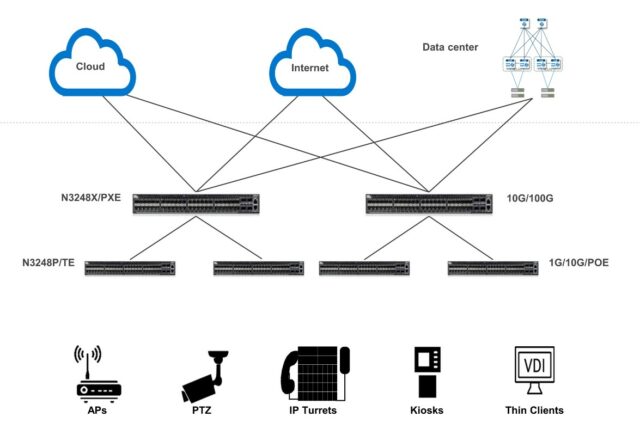Traditional networking products over the last several decades consisted of rigid and inflexible architectures of closed solutions that combined hardware + network operating system (NOS) + network management into one platform. These closed networking solutions were built around proprietary, non-standard and hardware-based technologies that tied customers to a single vendor and long development release cycles – resulting in costly rip-and-replace upgrades.
Dell Technologies took the market by storm in 2014 with our introduction of a new paradigm for networking – the disaggregation of hardware from software through our Open Networking initiative. Our vision consisted of giving customers a choice of NOS that best met their unique data center networking needs, while ensuring investment protection in their hardware purchases – a first step towards a true software-defined networking environment.
In 2016, Microsoft’s announced their contribution of Software for Open Networking in the Cloud (SONiC) to the Open Source community through which the networking technology took a revolutionary step forward with yet another level of disaggregation by breaking monolithic NOS into multiple containerized components. Through the use of containerization, SONiC provides network managers with plug and play extensibility and the ability to run third party, proprietary, or open-sourced application containers and update and perform in-service upgrades with zero downtime.
SONiC is changing the way customers look at networking – just like how Linux and Hadoop changed the world of operating systems and databases. And just like Red Hat who offers commercialized support for Linux, Dell Technologies offers a finely-tuned, enterprise ready and globally supported distribution of SONiC – called Enterprise SONiC Distribution by Dell Technologies – to help bring the benefits of hyper-scale-focused SONiC contributions to rest of the Enterprise and Telco markets and use cases.
Since our announcement and launch of the Enterprise SONiC Distribution by Dell Technologies in June 2021, we have continued to evolve this platform with feature additions for enterprise data center use cases, improving the manageability and validation of SONiC and creating a consistent API and CLI support for all features. Dell Technologies is one of the largest contributors to the SONiC community, contributing the design and implementation of several features including sFlow, Management VRF, Zero Touch Provisioning, NTP, PIM-SSM, Platform APIs, Streaming Telemetry and an intuitive CLI framework, called Management Framework. To further the SONiC momentum, Dell Technologies has built a landscape of eco-system partnerships with organizations like Apstra-Juniper, Augtera, and Dorado that offer solutions that simplify the management and monitoring of massive and complex networks. As we continue to evolve Enterprise SONiC, customers are responding positively.
“We need a way to upgrade and adopt the latest technologies and capitalize our existing infrastructure, ” commented one Enterprise customer. “Enterprise SONiC Distribution by Dell Technologies provides us with the means to create a common denominator across our network infrastructure, creating an environment that’s easier to use, allowing for quicker upgrades and faster deployment of mission-critical applications and services.”
Dell Technologies brings certain enterprise software functionality and support to the table that enables us to run SONiC confidently.” – Michael Munk Lassen, Head of Technology Infrastructure, team.blue.
Although SONiC originated in the cloud-scale datacenter network of a hyperscaler, its evolution has dovetailed with emerging market needs and trends to make it increasingly applicable to enterprise customers. Brad Casemore, Research Vice President, Datacenter Networks, reported that IDC is seeing growing demand for switches that ship with or will run SONiC, and forecasts a SONIC data center switch market that will reach $2.5 billion by 2025.
Today, we are introducing Enterprise SONiC Distribution by Dell Technologies 4.0, which extends SONiC capabilities from Data Center to Data Center, and out to the Edge, specifically for Retail and Branch use. This enables a unified fabric through a single NOS, from Data Center to Edge, allowing customers to streamline network deployment, operations and monitoring, all while using the same familiar network management tools they’ve grown accustomed to. In addition, this release brings support for datacenter interconnect (DCI), allowing management of SONiC installations across disparate sites and supporting an active-standby approach allowing business continuity, disaster recovery, increased application availability and simplified operations.
Simply said, Enterprise SONiC distribution by Dell Technologies 4.0 enables an end-to-end fabric with a lower total cost of ownership, streamlined operations, and reduced risk of disruption and downtime from unplanned outages or network performance issues, all supported through Dell’s Global 24×7 Enterprise support.
It’s been an exciting journey since our introduction of Open Networking over 8 years ago, Enterprise SONiC Distribution by Dell Technologies takes us into the next phase of open source networking and allows us to continue delivering on our promise of empowering customers with the networking choice and flexibility they need to help accelerate innovation, digital transformation, and grow new services within their businesses.



